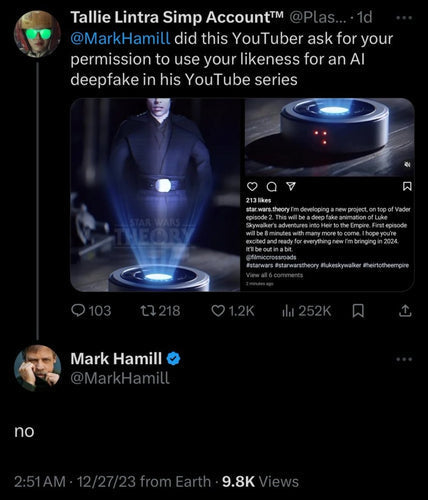
Deeply Troubled: When Luke Skywalker Took a Stand Against His Digital Doppelganger
Mark Hamill, the legendary Jedi Master himself, wasn't having it. In what unfolded like a real-life saga with shades of the Dark Side, a popular YouTube channel called Star Wars Theory attempted to create an "AI-powered Luke Skywalker Show" using deepfake technology – without Hamill's consent (Variety, July 12, 2022). This sparked a heated debate about artistic integrity, fan entitlement, and the ethical frontiers of deepfakes.
Deepfakes, for the uninitiated, are the digital equivalent of shape-shifting. They use artificial intelligence to seamlessly graft one person's face and voice onto another's, creating unsettlingly realistic simulations. Star Wars Theory, with its 5 million-strong fanbase, envisioned this technology as a way to bring back Luke Skywalker in a whole new way. Their plan? To create a Luke Skywalker impersonator whose every word and expression would be crafted by AI (The Hollywood Reporter, July 12, 2022).
But Hamill, a man who has wielded the lightsaber both on screen and in defending artistic integrity, wasn't about to let his likeness be digitally puppeteered. He publicly voiced his disapproval, citing concerns about deepfakes being misused for misinformation and the importance of artist autonomy over their image. "It's my face. My voice. My life. My career. It is not your playground," he tweeted on July 12, 2022, echoing the concerns of many who saw the project as a digital identity theft (The Verge, July 12, 2022).
Star Wars Theory, initially defensive, claiming their project was a non-profit fan film, eventually bowed to the pressure of Hamill's disapproval and public outcry. They apologized, scrapped the project, and assured fans the deepfake footage would never be released (Deadline, July 15, 2022). The Force, it seems, had spoken.
This saga offers more than just entertainment for Star Wars enthusiasts. It's a stark reminder of the ethical tightrope walk we're on with deepfakes. The technology's potential is undeniable, from resurrecting historical figures to creating hyper-realistic special effects. But unchecked, it's a two-edged lightsaber, capable of spreading misinformation, damaging reputations, and eroding our sense of reality.
Hamill's stand wasn't just about protecting his own image; it was a line drawn in the sand for all artists and the right to control their own creative output. In this digital age, where faces can be swapped like trading cards, the question of who owns our digital selves becomes more pressing than ever.
While Star Wars Theory learned a valuable lesson, the saga continues. Deepfake technology marches on, and with it, the need for a clear set of rules and ethical guidelines. This isn't a case of simply "may the Force be with you." We need a conscious effort, from creators to platforms and governments, to ensure that the next chapter in the deepfake story isn't one of manipulation and deceit, but one of responsible innovation and respect for individual identity.
Remember, with great power comes great responsibility. And when it comes to deepfakes, the Force needs a clear code of conduct to guide its use. May the conversation begin.
Sources:
- Variety (July 12, 2022): "Mark Hamill Slams Deepfake Luke Skywalker Video: 'It's My Face. My Voice. My Life. My Career'"
- The Hollywood Reporter (July 12, 2022): "Mark Hamill Objects to Deepfake Luke Skywalker in Star Wars Theory Fan Film"
- The Verge (July 12, 2022): "Mark Hamill slams Star Wars Theory for making a deepfake Luke Skywalker video without his permission"
- Deadline (July 15, 2022): "Star Wars Theory Cancels AI-Powered Luke Skywalker Show After Mark Hamill Objections"
